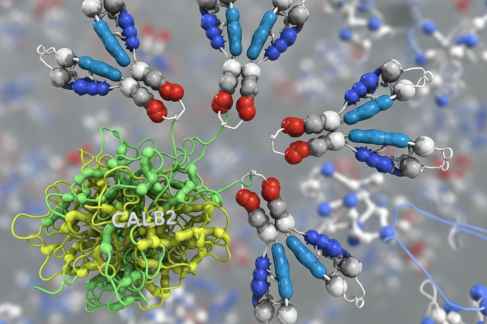Our brain is the communication system of our body. It relies on electrical signals that allow neurons to communicate with different parts of the body. However, when these electrical signals become overactive and unbalanced due to genetic factors, brain injury or trauma, infections, stroke, or reduced oxygen supply, tumors, metabolic or immune disorders, it leads to seizures.
These seizures can range from spells to full-body convulsions. This neurological condition is known as epilepsy. It can affect people of all ages and backgrounds. Some people experience mild seizures, whereas others may experience frequent and severe seizures, which may interfere with daily activities.
While the exact mechanism behind epilepsy is unknown, scientists and researchers rely on calcium-binding proteins, such as calretinin (CALB2), to understand epilepsy.
What is Calretinin (CALB2)?
Calretinin is a calcium-binding protein that is encoded by the CALB2 gene. It belongs to the EF-hand family. It is primarily expressed in specific populations of neurons within the central nervous system. It is responsible for buffering of intracellular calcium levels and regulating calcium-mediated signaling pathways.
Calcium ions (Ca²⁺) act as second messengers in several neuronal processes, such as neurotransmitter release, synaptic plasticity, and gene expression. Since prolonged or excessive calcium influx can trigger neuronal damage or death, maintaining calcium homeostasis is crucial.
It has been found that altered levels of calretinin can contribute to epileptogenesis. Reduced calretinin levels can weaken inhibitory control. This further leads to excessive neuronal firing and synchronization, which are hallmarks of seizures. On the other hand, overexpression or mislocalization of calretinin might also disrupt calcium dynamics and neuronal signaling, potentially affecting seizure thresholds.
So, measuring and localizing calretinin expression is crucial to understand different types of seizures. Here is where the CALB2 polyclonal antibody comes into play.
How CALB2 Polyclonal Antibody Helps in Epilepsy Research?
The CALB2 polyclonal antibody is a laboratory-produced antibody that specifically recognizes and binds calretinin. During epilepsy, these antibodies help scientists detect, visualize, and measure changes in calretinin expression in different parts of the brain. These valuable insights help:
Map Calretinin-Expressing Neurons
The CALB2 polyclonal antibody helps scientists identify neurons that produce calretinin. Researchers can visualize where calretinin is located by staining brain tissue with this antibody. These neurons are often found in regions such as the hippocampus and cortex — areas deeply involved in controlling brain activity and memory.
Mapping calretinin-positive neurons allows scientists to see how they are distributed in healthy brains versus epileptic brains. If these neurons are fewer or damaged in certain areas, it may indicate why that region becomes more prone to seizures. This mapping helps link structural brain changes to seizure activity patterns.
Study Neuronal Damage and Plasticity
Epilepsy often causes damage to neurons due to repeated abnormal electrical activity. The CALB2 polyclonal antibody helps detect whether calretinin-expressing neurons are damaged or lost after seizures.
Researchers can see how calretinin levels change after seizure episodes by comparing normal and epileptic brain tissue.
In some cases, neurons may try to adapt — a process known as neuronal plasticity. This means they alter their connections to maintain balance. The antibody helps study this adaptation and identify whether it protects against or contributes to seizures. This further helps develop new treatments that can prevent neuronal injury.
Investigate Calcium Dysregulation
Calcium plays a critical role in how neurons send and receive signals. Too much calcium inside a neuron can be toxic, leading to overexcitation or even cell death. Calretinin helps buffer or “absorb” excess calcium to protect neurons.
Scientists use the CALB2 polyclonal antibody to measure how calretinin expression changes in response to abnormal calcium levels during epilepsy. Reduced calretinin may lead to poor calcium buffering, making neurons unstable. Conversely, too much calretinin might interfere with normal calcium signaling.
This balance is delicate. Studying it helps researchers understand how calcium dysregulation contributes to epileptic seizures and how restoring calcium balance might control them.
Evaluate the Effects of Antiepileptic Treatments
Different antiepileptic drugs (AEDs) help stabilize electrical activity or control calcium and neurotransmitter levels. Researchers use CALB2 antibodies to test how these drugs affect calretinin-expressing neurons.
For example, after drug treatment, scientists can use immunostaining with the CALB2 antibody to check if calretinin levels are restored to normal or remain altered. This helps determine whether a treatment is effectively protecting neurons or reducing seizure activity.
Such experiments can also reveal whether a therapy has side effects that unintentionally disrupt calcium regulation. Therefore, CALB2 antibodies are useful tools for both drug testing and understanding treatment mechanisms.
The Bottom Line
The CALB2 polyclonal antibody is a powerful tool in epilepsy research. It helps scientists detect, measure, and map calretinin — a protein deeply linked to calcium balance and neuron stability.
Through these studies, researchers can better understand how calcium dysregulation and neuronal changes lead to seizures. It also supports the discovery of new and more effective treatments for epilepsy, ultimately improving the quality of life for patients affected by this condition.
However, using high-quality antibodies for your experiments is crucial. Otherwise, you may not get accurate results.


